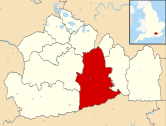Box Hill & Westhumble railway station
Box Hill and Westhumble | |
|---|---|
| General information | |
| Location | District of Mole Valley |
| Managed by | Southern |
| Platforms | 2 |
| Other information | |
| Station code | BXW |
| History | |
| Opened | 11 March 1867 |
Box Hill & Westhumble is a railway station in the village of Westhumble in Surrey, England,[2] approximately 2 miles (3.2 km) north of Dorking town centre. Box Hill is located approximately 1⁄2 mile (800 m) to the east. It is 21 miles 14 chains (34.1 km) down the line from London Waterloo. Train services are operated by Southern who manage the station, and South Western Railway.
The station is the end point for the Thames Down Link long distance footpath from Kingston upon Thames,[3] and lies close to the midpoint of the Mole Gap Trail between Leatherhead and Dorking.[4] The station is within 1⁄2 mile of the North Downs Way.
History

The station was constructed at the insistence of Thomas Grissell the owner of Norbury Park, in part compensation for the railway cutting across his land to the north of the village. The main building was designed by Charles Henry Driver[5] in the Châteauesque style and included steeply pitched roofs with patterned tiles and an ornamental turret topped with a decorative grille and weather vane.[6] The building is currently in use as a private dwelling and commercial premises and is protected by a Grade II listing.[7]
Grissell also obtained the right from the LBSCR to stop any train on request, a privilege subsequently exercised by Leopold Salomons, who purchased Norbury Park in 1890. This concession was legally abolished by the Transport Act of 1962, however there is no evidence to suggest that it was regularly used after 1910.[6]
The name of the station has changed many times over the years with "Box Hill" & "Boxhill" and "Westhumble" & "West Humble" used in varying combinations for signs, timetables and railway maps, with many inconsistencies.[8] In 2006, after consultation with local residents, the station's name was changed to "Box Hill and Westhumble" from "Boxhill and Westhumble".[citation needed]
| Year | Name of station |
|---|---|
| 1867 | West Humble for Box Hill |
| 1870 | Box Hill and Burford Bridge |
| 1896 | Box Hill |
| 1904 | Box Hill and Burford Bridge |
| 1958 | Boxhill and Westhumble |
| 2006 | Box Hill and Westhumble |
Services

Services at Box Hill & Westhumble are operated by Southern and South Western Railway (SWR). The off-peak service on weekdays and Saturdays (in trains per hour, tph) is:[9]
- 2 tph to London Waterloo via Wimbledon (SWR)
- 1 tph to London Victoria via Sutton (Southern)
- 2 tph to Dorking (SWR)
- 1 tph to Horsham via Dorking (Southern)
Additional services call during the peak periods. During Saturday evenings and Sundays, all southbound trains terminate at Dorking.
On Sundays the station also receives three trains per hour in each direction, however two are operated by Southern and one by South Western Railway.
| Preceding station | Following station | |||
|---|---|---|---|---|
| Leatherhead | Southern London Victoria to Horsham Mole Valley Line |
Dorking | ||
| South Western Railway London Waterloo to Dorking Mole Valley Line |
||||
Terrier tank engine

A Terrier tank engine, built by the LBSCR in 1880, was named Boxhill after the station.[10] It was used to haul commuter trains in South London and Surrey until the 1920s, when it was moved to become a shunting engine at Brighton. Unlike other engines of its class, its smokebox was not modified in the early 20th century, and it was restored by the Southern Railway in 1947 to its original condition and painted in its original Stroudley yellow ochre livery.[11] It is now preserved at the National Railway Museum in York.[10]
References
- ^ Historic England. "BOXHILL AND WEST HUMBLE RAILWAY STATION (1278326)". National Heritage List for England. Retrieved 12 September 2019.
- ^ "National Rail Enquiries – Station Facilities for Box Hill and Westhumble". National Rail. Retrieved 20 October 2010.
- ^ "Thames Down Link" (PDF). Surrey County Council. Archived from the original (PDF) on 22 June 2011. Retrieved 6 January 2011.
- ^ "Mole Gap Trail" (PDF). 60 Walks for 60 Years. Natural England. 2009. Archived from the original (PDF) on 30 September 2011. Retrieved 3 August 2011.
- ^ "Opening of the Dorking and Leatherhead Railway". Brighton Gazette. British Newspaper Archive. 21 March 1867. Retrieved 8 August 2016 – via British Newspaper Archive.
- ^ a b Jackson, Alan (1988). Dorking's Railways. Dorking Local History Group. ISBN 1-870912-01-2.
- ^ Heritage Gateway listing NGR TQ1674451848
- ^ Shepperd, Ronald (1991). Micklam the story of a parish. Mickleham Publications. ISBN 0-9518305-0-3.
- ^ "Update on timetable changes for May 2019" (PDF). www.southwesternrailway.com/plan-my-journey/timetables/update-on-timetable-changes-for-may-2019. South Western Railway. Retrieved 19 May 2019.
- ^ a b "Locomotives and rolling stock". Nrm.org.uk. 12 October 2009. Retrieved 1 October 2017.
- ^ "The Terrier Trust On The Web". Terriertrust.org.uk. Retrieved 19 May 2019.

